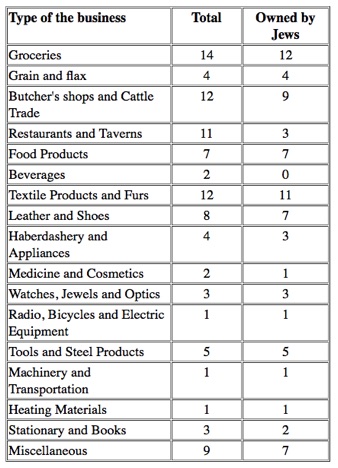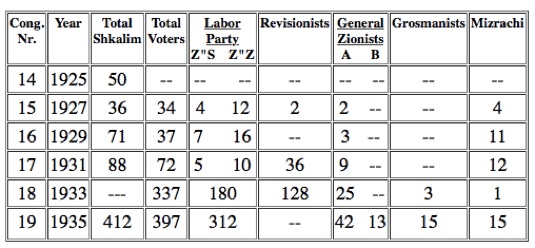Birzh, Lithuania

During the period of Independent Lithuania (1918-1940)
Society and Economy
After WWI Birzh remained the administrative center of the district, but its importance declined as the transport of goods via Birzh to Riga was restricted. Nevertheless the town developed, and the community gradually recovered, when some of the immigrants to Russia, who had been exiled, returned and also Jews from neighboring villages settled there. But the increasing number of Jews did not show up statistically in relation to the total population. Many Lithuanian villagers and government officials also settled in Birzh, yet the proportion of Jews had decreased by the middle of the thirties to only 36%, however 75% of the houses in town were owned by Jews.

At right: Stamp of the National Council of the Jews of Lithuania.
At left: Stamp of the Minister for Jewish affairs.
Following the law of autonomies for minorities issued by the new Lithuanian
government, the minister for Jewish affairs Dr. Menachem (Max) Soloveitshik ordered
elections to community committees (Va'ad Kehilah) to be held in the summer of 1919. In Birzh a "Va'ad Kehilah" of 15 members was elected: 6 General Zionists; 2 Tseirei Zion; 1 Mizrahi; 1 Akhduth (Agudath Yisrael); 3 Workers; 2 independent. The Va'ad was very active in the years 1920-1924 in Kehilah issues and got substantial administrative, financial and advisory assistance from the Ministry for Jewish Affairs in Kovno.
On the 12th of October 1922 the elections for the first Seimas (Parliament) took place. In Birzh the Jewish votes were divided as follows: the Zionist list got 426 votes, Akhduth-125 and the Democrats-13.
In the elections to the town council which took place in 1931, 9 Lithuanians and 3 Jews - Mordehai Smilg, Eliyahu Fridman and Zalman Vainer - were elected.
During this period many Jews made their living from flax and timber, while others were occupied in crafts, agriculture and peddling. Several Jews from Birzh and vicinity were employed in the two Jewish owned flour mills and in other light industry establishments. The flour mills also supplied a living to many Jewish families from Birzh and its surroundings who came there to grind their grain or to buy flour. The flour produced in these mills was packed in sacks and sold all over Lithuania.

A Street in Birzh
There were also Jewish owned weaving and knitting workshops as well as a flax processing workshop where several Jews were employed.
The 1931 government survey showed that there were then 99 businesses in Birzh, of which 77 were owned by Jews (78%), as detailed, according to type of business in the table below:
According to the same survey there were 45 factories in Birzh and of them 28 were Jewish owned (62%), as can be seen in the following table:
In 1931 there were 80 artisans including 63 Jews (79%): 8 tailors, 8 butchers, 6 wool workers, 6 shoemakers, 4 bakers, 4 wig makers, 2 saddlers, 1 tanner,1 hatter, 1 tinsmith and 22 others. They were organized in the "Union of Jewish Artisans"
At the beginning of the thirties 2 Jewish doctors (out of a total of 3), 2 Jewish lawyers (also 2 non Jewish) and 2 Jewish engineers (as well as1 non Jewish) worked in town.
In the middle of the thirties the economic situation of Birzh Jews began to deteriorate, because of competition from Lithuanian artisans and merchants. Despite the fact that there were 80 Jewish owned shops out of a total 118 in town, the aggressive propaganda from the union of the Lithuanian merchants "Verslas" against buying in Jewish shops had its negative effect on Jewish commerce.
The Jewish Folksbank played an important part in the economic life of Birzh Jews, although its beginning was modest: in 1922 it had 100 members (40 of them got loans totaling 40,000 Mark); by 1927 it already had 326 members and in 1929 there was a similar number - 321.
According to the official phone book of 1930 there were in Birzh 121 phone subscribers and of them 41 Jewish (see Appendix 4)
Education and Culture
Jewish children had the choice of studying among the various existing schools: the Hebrew "Tarbuth" school with about 180 pupils (its director for 16 years was Elimelekh Erez); the Yiddish school (1924-1939); the religious "Yavneh" school with about 40 pupils; several "Khadarim", or in the "Yeshivah" which was established in the thirties by the local rabbis Leib Bernshtein together with Benyamin Movsha. There was also a Jewish Kindergarten with about 30 children, active till World War II. A branch of the Yiddish Culture League operated a library with about 300 books, but with only 40 subscribers. Once the police arrested all the members of the League blaming them for Communist activity, and during the search of the library 25 books were confiscated.

The Hebrew Kindergarten with the teacher Pilvinsky-1939

(Identification by Hayim Giselevitz)
Honored Birzh men with the local Rabbi Yehudah-Leib Bernshtein
Standing from left: Mindlin, ---, Shne’ur Sundelevitz,Tabakin, Yitshak Mas, ---,Ratsemor
Sitting from left: ---, Mendel Dorfan, Rabbi Yehudah-Leib Bernshtein, Henkin, ---.
Occasionally Jewish theater companies would come to Birzh to present a show, and sometimes a cultural evening, such as a "Literary Judgment", would take place. Because of the dearth of cultural life people would gather on Shabath afternoon in the Beith-Midrash for a chat on economic or political issues.
Zionist and other public activities
Almost all Zionist parties were represented. The table below shows how Birzh Zionists voted for the different parties during the six Zionist Congresses:

A group of "Hashomer-Hatsair" members 1929
Standing in first line from right: Khyenke Tabakin; fifth-Bronia Rubin;
Standing in first line from left: second-Shefke Ezrakhovitz;
Kneeling in last line below from left: Hinda Shakhar

(Photo supplied by Sheine Roznikovitz-Pres)
Group of "Hashomer-Hatsair" members
Standing from right: Gita Vishkin, Esther Gude, Yankelevitz, Sheine Roznikovitz,
Bilhah Nakhumovitz, ---.
Sitting in second line from right: ---, Itke Moril, Hinda Shakhar, Nahum Levitas
Sitting in third line: Tsivyah Vishkin, Zundl Fin.
Zionist youth organizations active in Birzh included "HeKhalutz", "HaShomer HaTsair", "Beitar", "Gordonia" had 60-70 members the leaders being Peretz Shek and A.Perl, and "Benei-Akiva". The sports movements were "Macabi" with about 50 members and a rather less active branch of "HaPo'el".
Many Birzh Jews were members in the local voluntary fire brigade and were well represented in its management, and since it owned three fire engines it was the third in size after Kovno and Shavli.
Religion and Welfare
Most of Birzh Jews were "Mithnagdim" who maintained two "Beth-Midrash" (one was called the Great), there were also one Synagogue, two "Klois" (Prayer houses), one of the shoemakers, the other of the "Shamashim" (caretakers of prayer houses). There were also Khasidim who had their own prayer house as well as several "Minyanim", among them one of "Habad" and another of "Po'alei Tsedek".
The Jewish welfare institutions included "Gemiluth Khesed" which lent small loans without interest; "Linath HaTsedek" (care for the ill), "Moshav Zekeinim" (Home for the aged), 'Maskil el Dal" (delicate support to people who lost their living), "Lekhem Aniyim" (Bread for the Poor).


Right Photo: Birzh "Macabi" 1923? (Picture supplied by Eti Sherman-Bruskin)
Left photo: The Sherman Sisters-April 1936.
From left: Yentl (Eti), Feige, Rachel

(Picture supplied by Eti Sherman-Bruskin)
A Party in Birzh-May 1937
Standing from right: ---, Feige Sherman, Shemuel Ferber, Mosheh Rapeika,
Hanah-Sarah Morein, (Aunt of Hanah-Sarah ?), (Mother of Hanah-Sarah ?).
Sitting from right: Shemuel Reznikovitz, Tsivyah Gurvitz, Hanah Bokher, Aryeh Ferber, Levin ?, ---, ---, Itke Bokher, Miriam Liman, Shne’ur Propis, Miriam Ger, Mosheh Tselkovitz, Sarah Sherman
The "OZE" organization, dealing mainly in preventative medicine amongst Jewish school children, had its clinic in Birzh and also served children from the vicinity.
With the deterioration of the economic situation of Birzh Jews before WWII, the OZE clinic closed down and the Artisan Union stopped its activity. Only the "Moshav-Zekeinim" which in 1935 housed six aged persons, four women and two men, continued its activity. The prayer houses and the welfare institutions continued to function rather poorly.
Relations between Jews and Lithuanians during this period were generally normal, although cold not close. The Lithuanians lived in their alleys and the Jews in the center of the town. During these years anti-Semitism began to rear its head.
(For a partial list of personalities born in Birzh see Appendix 3)









